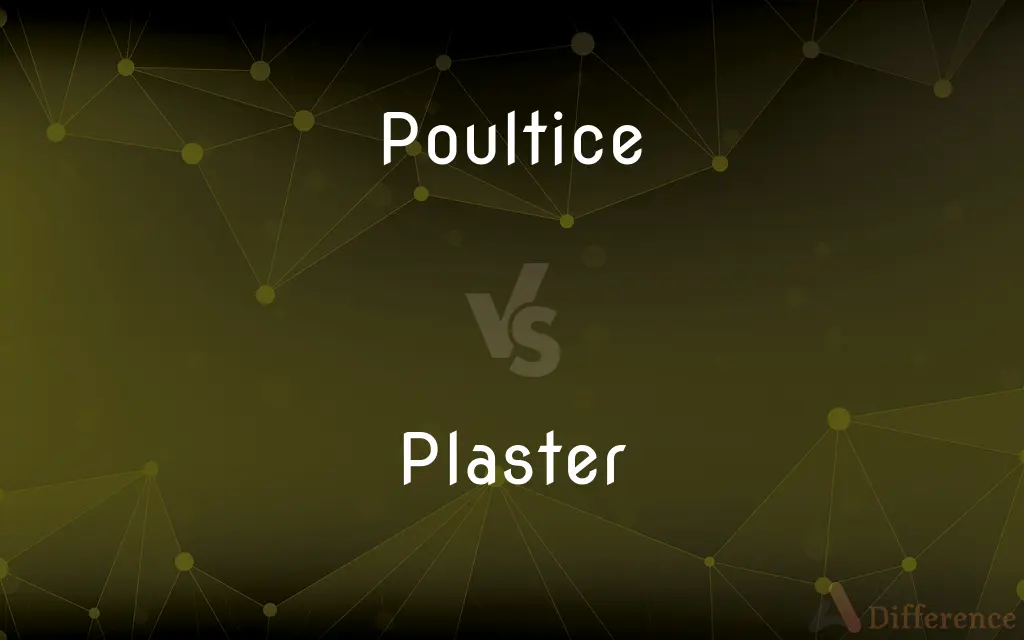Poultice vs. Plaster — What's the Difference?
By Urooj Arif & Fiza Rafique — Updated on May 1, 2024
Poultices are soft, moist substances used for medical or therapeutic purposes, applied directly to the skin to relieve soreness or inflammation; plasters, are a mixture of substances that harden to form a protective coating, used in building construction.

Difference Between Poultice and Plaster
Table of Contents
ADVERTISEMENT
Key Differences
Poultices typically consist of plant material, mud, or clay, made into a paste and spread on a cloth before being applied to the skin to treat abscesses, inflammation, or pain. Plasters, on the other hand, can refer to a building material made of sand, lime, and cement used to coat walls and ceilings or to a stiff, adhesive bandage used to protect minor wounds.
The application of a poultice is usually for medicinal or healing purposes, leveraging the natural properties of its components to draw out infections or soothe pains. Conversely, plasters are used primarily for protective reasons, either to safeguard an injury by covering it with a bandage or to shield a structure by adding a smooth, durable surface layer.
Poultices are designed to be temporary and are changed frequently to maintain their effectiveness. In contrast, plasters, especially those used in construction, are meant to be long-lasting, providing a permanent or semi-permanent finish to surfaces.
Another distinction lies in the preparation; poultices are often prepared as needed, using fresh ingredients and applied warm or cold depending on the treatment required. Plasters require a specific preparation process involving mixing and sometimes cooking ingredients to achieve the right consistency for application.
Despite their different purposes and applications, both poultices and plasters share the concept of covering an area. However, where poultices use organic or raw ingredients aimed at treatment by application to the body, plasters often use synthesized or prepared materials for structural enhancement or protection.
ADVERTISEMENT
Comparison Chart
Primary Use
Medicinal, to treat inflammation and draw out toxins
Construction, surface finishing; medical bandages
Composition
Organic materials like herbs, clay, or mud
Sand, lime, cement; or medicinal adhesive
Application
Directly to the skin with a cloth
Applied to walls or directly to the skin
Duration
Temporary, changed frequently
Long-lasting, depending on the type
Preparation
Freshly prepared, can be warm or cold
Pre-mixed, sometimes requires cooking
Compare with Definitions
Poultice
A remedy involving such a material often wrapped in cloth.
He used a bread poultice to draw out the infection.
Plaster
A mixture of lime, sand, and water that hardens when dried, used for coating walls.
They smoothed the wet plaster onto the wall with a trowel.
Poultice
A therapeutic application usually made from plant materials.
The herbalist recommended a poultice made from lavender.
Plaster
A medical dressing made from a rigid material, especially to immobilize broken bones.
Her broken wrist was set in a plaster cast.
Poultice
Can be heated or cooled depending on the treatment.
A cold poultice was applied to reduce the swelling.
Plaster
Can refer to a small adhesive bandage used in first aid.
He put a plaster on the small cut.
Poultice
A soft, moist mass of material applied to the body to relieve soreness and inflammation.
She applied a poultice of mashed leaves to the bruise.
Plaster
Plasters can be decorative, like in ornamental ceiling work.
The restoration involved repairing the intricate plaster ceiling.
Poultice
Historically, poultices were used to treat boils and abscesses.
Poultices were common in medieval medicine for treating skin ailments.
Plaster
Used historically in sculptures and mold making.
The artist crafted a detailed sculpture from plaster.
Poultice
A poultice, also called a cataplasm, is a soft moist mass, often heated and medicated, that is spread on cloth and placed over the skin to treat an aching, inflamed or painful part of the body. It can be used on wounds such as cuts.
Plaster
Plaster is a building material used for the protective or decorative coating of walls and ceilings and for moulding and casting decorative elements. In English, "plaster" usually means a material used for the interiors of buildings, while "render" commonly refers to external applications.
Poultice
A soft moist mass of bread, meal, clay, or other adhesive substance, usually heated, spread on cloth, and applied to warm, moisten, or stimulate an aching or inflamed part of the body. Also called cataplasm.
Plaster
A mixture of lime or gypsum, sand, and water, sometimes with fiber added, that hardens to a smooth solid and is used for coating walls and ceilings.
Poultice
To apply a poultice to.
Plaster
Plaster of Paris.
Poultice
A soft, moist mass, usually wrapped in cloth and warmed, that is applied topically to a sore, aching or lesioned part of the body to soothe it.
Plaster
A pastelike mixture applied to a part of the body for healing or cosmetic purposes.
Poultice
A porous solid filled with solvent, used to remove stains from porous stone such as marble or granite.
Plaster
Chiefly British An adhesive bandage.
Poultice
(transitive) To treat with a poultice.
Plaster
To cover, coat, or repair with plaster.
Poultice
A soft composition, as of bread, bran, or a mucilaginous substance, to be applied to sores, inflamed parts of the body, etc.; a cataplasm.
Plaster
To cover or hide with or as if with a coat of plaster
Plastered over our differences.
Poultice
To apply a poultice to; to dress with a poultice.
Plaster
To apply a plaster to
Plaster an aching muscle.
Poultice
A medical dressing consisting of a soft heated mass of meal or clay that is spread on a cloth and applied to the skin to treat inflamed areas or improve circulation etc.
Plaster
To cover conspicuously, as with things pasted on; overspread
Plaster the walls with advertising.
Poultice
Dress by covering with a therapeutic substance
Plaster
To affix conspicuously, usually with a paste
Plaster notices on all the doors.
Plaster
To make smooth by applying a sticky substance
Plaster one's hair with pomade.
Plaster
To make adhere to another surface
"His hair was plastered to his forehead" (William Golding).
Plaster
To inflict heavy damage or injury on.
Plaster
To defeat decisively.
Plaster
To apply plaster.
Plaster
(uncountable) A paste applied to the skin for healing or cosmetic purposes.
Plaster
A small adhesive bandage to cover a minor wound; a sticking plaster.
Plaster
(uncountable) A mixture of lime or gypsum, sand, and water, sometimes with the addition of fibres, that hardens to a smooth solid and is used for coating walls and ceilings; render, stucco.
Plaster
(countable) A cast made of plaster of Paris and gauze; a plaster cast.
Plaster
(uncountable) plaster of Paris.
Plaster
(transitive) To cover or coat something with plaster; to render.
To plaster a wall
Plaster
(transitive) To apply a plaster to.
To plaster a wound
Plaster
(transitive) To smear with some viscous or liquid substance.
Her face was plastered with mud.
Plaster
(transitive) To hide or cover up, as if with plaster; to cover thickly.
The radio station plastered the buses and trains with its advertisement.
Plaster
To bombard heavily or overwhelmingly; to overwhelm with (weapons) fire.
Plaster
To smooth over.
Plaster
An external application of a consistency harder than ointment, prepared for use by spreading it on linen, leather, silk, or other material. It is adhesive at the ordinary temperature of the body, and is used, according to its composition, to produce a medicinal effect, to bind parts together, etc.; as, a porous plaster; sticking plaster.
Plaster
A composition of lime, water, and sand, with or without hair as a bond, for coating walls, ceilings, and partitions of houses. See Mortar.
Plaster
Calcined gypsum, or plaster of Paris, especially when ground, as used for making ornaments, figures, moldings, etc.; or calcined gypsum used as a fertilizer.
Plaster
To cover with a plaster, as a wound or sore.
Plaster
To overlay or cover with plaster, as the ceilings and walls of a house.
Plaster
Fig.: To smooth over; to cover or conceal the defects of; to hide, as with a covering of plaster.
Plaster
A mixture of lime or gypsum with sand and water; hardens into a smooth solid; used to cover walls and ceilings
Plaster
Any of several gypsum cements; a white powder (a form of calcium sulphate) that forms a paste when mixed with water and hardens into a solid; used in making molds and sculptures and casts for broken limbs
Plaster
A medical dressing consisting of a soft heated mass of meal or clay that is spread on a cloth and applied to the skin to treat inflamed areas or improve circulation etc.
Plaster
A hardened surface of plaster (as on a wall or ceiling);
There were cracks in the plaster
Plaster
Adhesive tape used in dressing wounds
Plaster
Cover conspicuously, as by pasting something on;
The demonstrators plastered the hallways with posters
Plaster
Affix conspicuously;
She plastered warnings all over the wall
Plaster
Apply a plaster cast to;
Plaster the broken arm
Plaster
Apply a heavy coat to
Plaster
Coat with plaster;
Daub the wall
Plaster
Dress by covering with a therapeutic substance
Common Curiosities
What are the common ingredients in a poultice?
Common ingredients include clay, herbs, and other natural materials.
How do plasters used in construction differ from medicinal plasters?
Construction plasters are used for coating and finishing surfaces, whereas medicinal plasters are typically used for protecting wounds or immobilizing body parts.
How long should a poultice be left on the skin?
It varies, but typically a poultice is left on for a few hours or as advised by a healthcare provider.
What are the benefits of using a plaster in construction?
Plaster provides a smooth, durable surface and helps control the interior climate of buildings.
What is the main purpose of a poultice?
Poultices are primarily used for medicinal purposes, such as drawing out infections and soothing inflammation.
Can a poultice be reused?
Generally, poultices are not reused; they are replaced with fresh materials to maintain effectiveness.
What are the safety concerns with using poultices?
If not properly prepared or if left on too long, poultices can cause skin irritation or infection.
Is plaster environmentally friendly?
Traditional plaster can be environmentally friendly as it is made from natural materials, but the environmental impact can vary based on additives.
Are there modern alternatives to plasters in medical use?
Yes, modern alternatives like fiberglass casts are often used instead of traditional plaster casts due to their lighter weight and greater durability.
How should plaster be stored before use?
It should be kept dry and sealed to prevent it from setting before use.
Share Your Discovery

Previous Comparison
Value vs. Money
Next Comparison
Rating vs. RateAuthor Spotlight
Written by
Urooj ArifUrooj is a skilled content writer at Ask Difference, known for her exceptional ability to simplify complex topics into engaging and informative content. With a passion for research and a flair for clear, concise writing, she consistently delivers articles that resonate with our diverse audience.
Co-written by
Fiza RafiqueFiza Rafique is a skilled content writer at AskDifference.com, where she meticulously refines and enhances written pieces. Drawing from her vast editorial expertise, Fiza ensures clarity, accuracy, and precision in every article. Passionate about language, she continually seeks to elevate the quality of content for readers worldwide.
















































